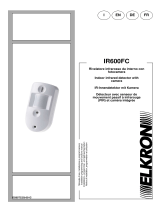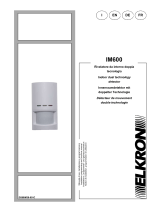
16
INSTALLAZIONE DEL RIVELATORE
Scegliere la posizione di installazione del microfono selettivo RK66S e tener
conto dei potenziali falsi allarmi per cui:
Posizionare il dispositivo su di una superficie quanto più immune possibile a
vibrazioni estranee e quanto più vicino possibile alla superficie da proteggere
se quest’ultima è in cemento armato. Per l’installazione su superfici
metalliche rimuovere da queste ultime eventuali residui di vernice. Non usare
assolutamente pasta di silicone tra il sensore e la superficie di installazione.
Per ottenere la migliore rilevazione di vibrazione possibile, le superfici di
installazione devono essere lisce. Utilizzare la piastra di montaggio (vedere
la Figura 2) quando si effettua l’installazione su di una superficie di mattoni,
calcestruzzo o su di una superficie metallica resistente al trapano. La piastra
di fissaggio può anche essere saldata sulle superfici metalliche.
Regolare tramite i microinterruttori la sensibilità, il tempo di intervento e gli
altri parametri (vedere la sezione Predisposizione dei microinterruttori).
Ricordare la relazione tra la sensibilità ed il materiale componente la
superficie da proteggere considerando che i microfoni configurati per un’alta
sensibilità possono essere distanziati fino a 5 metri dalla superficie da
proteggere (ad esempio quando la superficie dell’oggetto è di metallo) la cui
verifica può essere effettuata con l’utilizzo di un martello o sfregando la
superficie stessa.
Regolare tramite i microinterruttori la sensibilità, il tempo di intervento e gli
altri parametri (vedere la sezione Predisposizione dei microinterruttori).
Ricordare la relazione tra la sensibilità ed il materiale componente la
superficie da proteggere considerando che i microfoni configurati per un’alta
sensibilità possono essere distanziati fino a 5 metri dalla superficie da
proteggere (ad esempio quando la superficie dell’oggetto è di metallo) la cui
verifica può essere effettuata con l’utilizzo di un martello o sfregando la
superficie stessa.
Rimuovere le viti di fissaggio del coperchio per separare quest’ultimo dalla
base, vedere la Figura 1(A) / 2(B).
Forare la superficie di installazione usando la base del sensore o la piastra di
fissaggio come dima. Procedere come segue:
Figura 1: Installazione del microfono selettivo direttamente su di una superficie
metallica




























